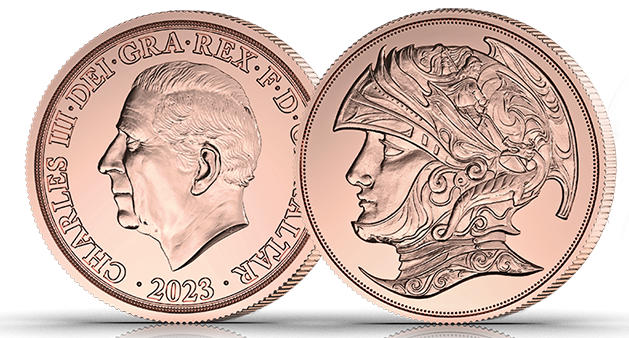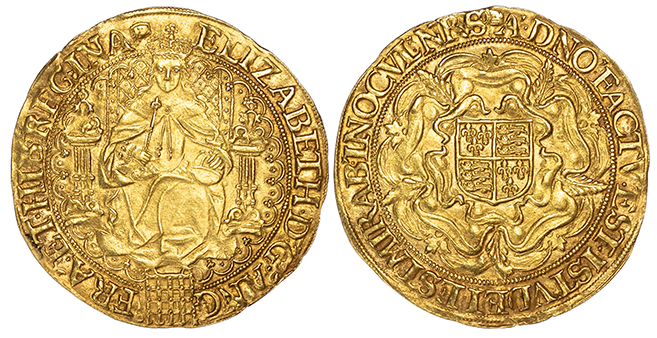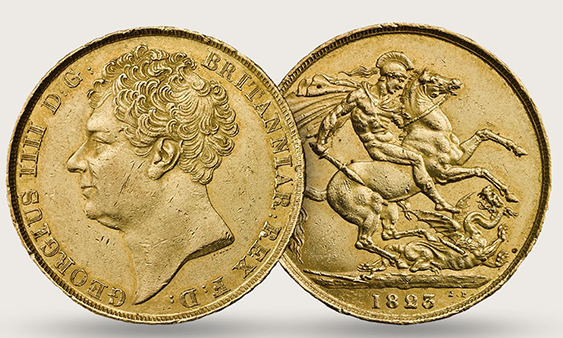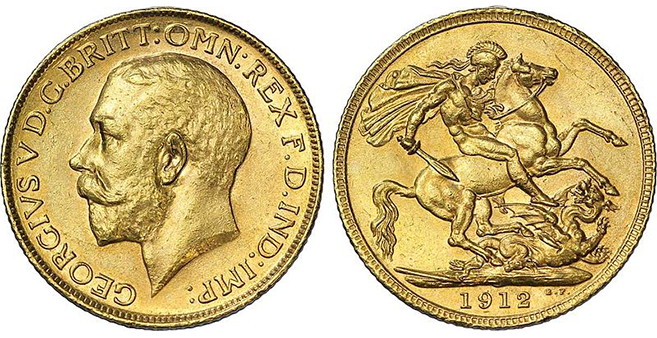History of UK Sovereign Gold Coins

Definition of a Sovereign Gold Coin
A sovereign gold coin is a type of bullion coin that is traditionally minted in the United Kingdom and comes with a well-known and rich history. The coin is made of pure gold and is considered legal currency in Great Britain. Since its inception, the sovereign coin has been regarded as a symbol of wealth and power, and it remains a popular investment choice for those who want to protect their assets from inflation and currency fluctuations. In this article, we’ll take a closer look at the history of UK sovereign gold coins, including their design, features, and benefits.
Brief Overview of UK History
The history of UK Sovereign Gold coins is closely intertwined with the political changes and events that occurred throughout the country's history. The development of the Sovereign coin took root in the Tudor period, with Henry VII's introduction of the first gold sovereign in 1489. During the Tudor period, the use of coins as a form of currency spread widely throughout the country, replacing the use of bartering as a means of procuring goods.
Following the Tudor period, the reign of the Stuart monarchs, including James I and Charles I, saw an increased demand for gold coins as trade with other countries grew. However, the English Civil War led to significant political and economic changes in the country, which ultimately impacted the development of sovereign coins.
During the Commonwealth and Protectorate period, new types of coins were introduced, including the broad of 20 shillings and the triple unites of 60 shillings. These coins were produced in an attempt to stabilize the country's economic situation, but their large size and high value made them difficult to distribute and led to limited circulation.
Despite these challenges, the use of gold coins continued throughout the country's history, especially during times of war and economic instability. With the rise of the British Empire and the country's growing economic power, demand for gold coins increased rapidly.
Today, the Royal Mint continues to produce modern gold sovereign coins, which are highly valued by collectors and investors alike. The weight and gold content of these coins remains unchanged since their introduction, further emphasizing the importance and enduring legacy of UK sovereign gold coins in the country's history.
Pre-1700's

Pre-1700s: The history of UK sovereign gold coins dates back to the Tudor period when King Henry VII introduced the first gold sovereign coin in 1489. It was a significant departure from previous gold coinage as it featured a distinctive design with Henry VII's portrait on the obverse and a shield on the reverse. The sovereign quickly became a symbol of English prosperity and trade and has since undergone several design changes while retaining its position as a cornerstone of British coinage.
Early Coins in the British Isles
Having been inhabited for thousands of years, the British Isles have a long and fascinating history when it comes to coinage. Coinage in early Britain began with the use of Roman coins as currency before the Britons began minting their own coins in the late 8th century.
Some of the earliest British coinage include the gold Thrymsas and the silver Sceattas. Thrymsas were tiny and usually featured a stylized bust on one side, while the reverse displayed various animal designs or symbols. Sceattas were also small and silver, with a variety of designs including animals, people, and religious symbols.
However, the arrival of Vikings and Anglo-Saxon invaders brought their own currency to Britain, leading to the introduction of new coin designs. The Vikings introduced their own coins with unique designs, while the Anglo-Saxons produced coins featuring the faces of kings and saints.
Overall, the early coinage of the British Isles was a reflection of the constantly changing power dynamics and cultural influences of the people living and trading in the region. These early coins were a small but important part of the complex history of Britain and served as a legal currency for many decades.
Henry VII and the Sovereign Coin
Henry VII played a key role in the creation of one of the most iconic and impressive coins in British history – the Sovereign Coin. During his reign in the late 15th century, he sought to make his mark on the British currency and issued a new gold coin with an impressive design and composition.
The Sovereign quickly became the grandest and most impressive coin ever issued in English history, with its size and weight reflecting the power and wealth of the Tudor monarchs. It was popular not just in England, but also across Europe, where the intricate design captured the imagination of collectors and investors alike.
The original Sovereign created by Henry VII was composed of 23-carat gold, with a weight of about one-quarter ounce. This made it a relatively large and heavy coin, and its design was intricate and detailed. On one side was a depiction of the king seated on his throne, while the reverse featured a stylized image of Saint George slaying a dragon.
Subsequent Tudor rulers made changes to the composition and design of the Sovereign, but it remained one of the most sought-after coins in circulation. The purity of gold was reduced under the reign of Henry VIII, who wanted to increase the quantity of gold available for his own personal use. Later Tudor monarchs made further changes to the design, adding inscriptions and mint marks to differentiate between coins issued at different mints across the country.
Despite these changes, the Sovereign remained an impressive and respected coin, symbolizing the wealth and power of the Tudor dynasty. Today, the Sovereign is still in circulation as a modern gold bullion coin, with its weight and composition carefully monitored to ensure its value remains consistent with the original money of gold issued by Henry VII.
Elizabeth I and the Pound Sterling
Elizabeth I played a significant role in the establishment of the Pound Sterling. Her reign heralded the end of the Tudor period, during which the official coinage was the gold sovereign. Under her rule, the sovereign continued to be struck, but she also introduced several other coins, including the sixpence, threepence, and penny. However, it was her successor, James I, who struck some of the most historic coins in English history, including the "unite," a gold coin worth 20 shillings, and the "rose-ryal," a gold coin worth 30 shillings.
The Pound Sterling, which was initially introduced in 1158, became the official currency of England during the reign of Elizabeth I. The pound was initially valued at one troy pound of silver, which was then divided into 240 pence. Throughout the centuries, the pound continued to be the standard currency in England, and in 1821, it was officially defined as a specific weight of gold, making it a true gold standard currency. Since then, the Pound Sterling has remained the official currency of England, and it is widely used as a global currency.
In summary, Elizabeth I played a crucial role in the establishment of the Pound Sterling, which went on to become the official currency of England. Her reign marked the end of the Tudor period, during which sovereigns were the official coinage, but she introduced several other coins. Her successor, James I, went on to strike some of the most historic coins in English history, including the unite and rose-royal. The Pound Sterling remains a widely used currency and is a testament to England's rich history and cultural heritage.
1700's
During the 1700s, the world was changing rapidly, and England was at the forefront of much of that change. The industrial revolution was in full swing, and with new technologies came new wealth. This newfound affluence created a demand for luxury goods, including gold coins. It was during this time that the idea for the first gold sovereign was born, and it was the beginning of a long and storied history of gold coins in England.
George III and the Value of Gold Coins
George III is a significant figure when it comes to the value and production of gold coins in the UK. During his reign, there was a shortage in the quantity of gold coins available, which led to their inflated value. The scarcity was partly due to the export of gold coins to other countries in Europe where they were melted down to make new coins.
To address this issue, George III established the Royal Mint in London in 1809. This allowed for the centralized production of gold coins, which helped to stabilize their value. It was also during his reign that the iconic sovereign coin was introduced, which further cemented the UK's position as a leading producer of gold coins.
One of the most significant events during George III's reign was the "Great Recoinage" of 1816. This was an effort to restore confidence in the UK's currency following the economic turmoil of the Napoleonic Wars. It involved the replacement of all existing gold coins with new coins made from a standardized weight and composition.
As part of this effort, the weight of the gold sovereign was reduced from 7.98 grams to 7.32 grams, although its diameter was increased slightly. The composition of the coin was also changed, with an increase in the amount of copper added to the alloy. This new version of the sovereign became known as the "new coinage," and it remained in circulation until the end of the 19th century.
During George V's reign, gold sovereigns were produced at branches of the Royal Mint in Sydney, Melbourne, Perth, Ottawa, and Bombay. The mintage figures per year varied based on demand, but some of the highest mintage years were between 1913 and 1918, during World War I.
It's worth noting that the production of gold sovereigns was also affected by the Gold Standard Act of 1816. This legislation established the gold standard as the basis for the UK's monetary system, and it required the Bank of England to hold a specific amount of gold reserves. This meant that the demand for gold coins, including sovereigns, increased, as they were legal tender and had a fixed gold content.
Overall, George III's establishment of the Royal Mint and the "Great Recoinage" of 1816 had a significant impact on the production, quality, and value of gold coins in the UK. These changes helped to stabilize the country's currency and established the UK as a leading producer of gold coins.
Establishment of the Royal Mint in London
The history of the British coinage system dates back to Roman times, but it was only during the 16th century that England began to establish a centralized mint to produce gold coins. However, the manufacturing of coins during this period was chaotic and suffered from a lack of standardization.
It wasn't until the reign of George III that the Royal Mint was officially established in London in 1809. The creation of the mint was crucial for the development of the British coinage system, marking a shift from decentralized production to a centralized and standardized system. With the introduction of the Royal Mint, the production of coins became more consistent and reliable, which helped to stabilize their value.
The Royal Mint in London played a significant role in the production of gold sovereigns, which became one of the most iconic gold coins produced by the British Empire. The sovereign was first introduced during the reign of Henry VII, but it was George III who standardized its production and made it a legal currency by law.
The mint was responsible for engraving the portraits of monarchs on the coins, with different designs introduced by each monarch. The portraits of George III, George IV, William IV, Victoria, Edward VII, George V, Edward VIII, and Elizabeth II all featured on sovereign gold coins produced by the Royal Mint over the years, reflecting the politics and economic conditions of the time.
The Royal Mint played a crucial role in monitoring the weight and gold content of the sovereigns by adding a mint mark, which guaranteed their authenticity. The weight and gold content of the sovereign also played a significant role in the value of the coin, which was a direct reflection of the economic and political stability of the country.
Overall, the establishment of the Royal Mint in London was a major milestone in the history of the British coinage system, setting a standard for producing reliable and valuable gold coins. The mint's role in the production of sovereigns helped to promote British influence and establish their dominance as a leading producer of gold coins for centuries to come.
George III’s “Great Recoinage”
George III's "Great Recoinage", which took place between 1816 and 1818, was a significant event that impacted the British currency in the 18th century. This recoinage was necessary due to the fact that the existing coins in circulation were worn out, clipped, or counterfeited, which caused confusion and inconsistency in their value.
During this recoinage, new and standardized coins were introduced, including the gold sovereign, which featured a new and modern design. The new gold sovereign was minted with 7.98 grams of 22-carat gold, which equaled one pound sterling in value. The new design featured a portrait of King George III on one side, and the image of St. George slaying the dragon on the reverse.
This recoinage had a significant impact on the British economy as it restored confidence in the currency and stabilized its value. The new coins were smaller and lighter compared to the older coins but contained the same amount of precious metal, which made them easier to transport and handle. The recoinage was successful in reducing the amount of counterfeiting and clipping, which resulted in a more consistent and reliable currency system.
The Great Recoinage had some short-term negative effects on the economy, as people were required to exchange their old coins for new ones at the Bank of England, which caused some inconvenience. Additionally, the new coins were not readily available in circulation, which caused a shortage of money in the short term. However, in the long run, this recoinage had a positive impact on the British economy as it improved the efficiency of trade and commerce and helped to stimulate economic growth.
Overall, George III's "Great Recoinage" was a crucial event that brought significant changes to the British currency and had a lasting impact on the economy. The introduction of the new gold sovereign was a significant part of this recoinage, which played a crucial role in restoring confidence and stability in the currency system.
1800's

The 1800s saw a significant shift in British coinage, with the introduction of new sovereign gold coins and recoinage efforts. These events would shape the country's monetary system for years to come, as the country transitioned to a more modern and efficient currency system. From the reigns of Queen Victoria and King Edward VII to the Great Recoinage of 1816, the 1800s was a time of change and innovation for British gold coins and the Royal Mint.
The Gold Standard Act of 1816
The Gold Standard Act of 1816 marked a significant turning point in the history of UK sovereign gold coins. This act was passed by the British parliament to establish a fixed gold price for the pound sterling, a move that led to the mass production of gold sovereigns and the adoption of the gold standard as a benchmark for international currency exchange.
Prior to this act, gold coins in Britain had been minted irregularly, with varying weights and fineness levels. This made it difficult for merchants and traders to conduct transactions that required a standard measure of value. The passage of the Gold Standard Act helped to standardize the weight and fineness of gold coins, making them suitable for use as legal currency.
The act paved the way for the mass production of gold sovereigns, which quickly became a symbol of British economic power and a popular currency around the world. The sovereign coin bore the design of the reigning monarch, as well as the image of St. George slaying the dragon on the reverse side.
The Gold Standard Act of 1816 was a major step towards stabilizing the British economy and solidifying the country's position as a leading economic power. The act's establishment of a fixed gold price for the pound sterling ensured that the country's finances were based on a stable, reliable standard.
Over time, the sovereign gold coin became a cherished item for collectors and investors alike. The quantity of gold used to mint a sovereign remained consistent, and its intrinsic value ensured that it remained a safe store of wealth. Today, the sovereign gold coin remains one of the most iconic British coins, with its design and status continuing to capture the imagination of collectors and investors around the world.
In conclusion, the Gold Standard Act of 1816 was a pivotal moment in the history of UK sovereign gold coins. It paved the way for the mass production of gold sovereigns, cemented the gold standard as a benchmark for international currency exchange, and helped to stabilize the British economy. The act's legacy lives on today, ensuring that the sovereign gold coin remains a prized piece of British numismatic history.
Queen Victoria and Her Golden Jubilee
Queen Victoria's Golden Jubilee marked her 50th year on the throne as the Queen of England. The event was held in 1887 and it was a significant milestone in the history of the UK Sovereign Gold Coins. The Golden Jubilee commemorated her reign and the many changes that had taken place in the country during that time.
The celebration of the Golden Jubilee was a grand affair, with parades, fireworks displays, and commemorative events held throughout the country. It was a time of great national pride and people from all parts of the country came together to celebrate the Queen's reign. The celebration also played a major role in the production of gold sovereigns at the time.
The Royal Mint had already been producing sovereign coins with the image of Queen Victoria on the obverse side, but the reverse side had remained unchanged for decades. The Golden Jubilee presented an opportunity to redesign the reverse image of the coin to commemorate the occasion.
The new design depicted a shield within a garter on the reverse side of the coin, replacing the previous design that featured St. George and the Dragon. The new design was given the name "Jubilee Head" and later became known as the "Veiled Head" due to the drapery worn by Queen Victoria in the design. The redesign was released to the public in 1887 as a special edition of the sovereign coin to commemorate the Queen's Golden Jubilee.
The commemorative sovereign coin was a great success and became highly sought after by collectors and investors alike. The redesign signaled a shift in the perception of the sovereign coin, from a coin used for everyday transactions to a symbol of national pride and history.
In conclusion, Queen Victoria's Golden Jubilee in 1887 was a significant event that had a major impact on the production of UK Sovereign Gold Coins. The redesign of the reverse image of the coin to commemorate the occasion gave rise to a new era of commemorative coins and highlighted the coin's significance as a symbol of national history and pride.
1900's to Present Day

From the turn of the 20th century to the present day, the history of UK sovereign gold coins has been one of continued popularity and innovation. As the world experienced significant changes in technology, politics, and economics, the British sovereign coin continued to be a trusted and valuable form of currency for people all over the world. Over the years, the sovereign coin has evolved to reflect the changing times, while still maintaining its character and prestige as a symbol of the United Kingdom's rich history and heritage.
Edward VII and His Coronation Coinage
King Edward VII ascended to the British throne in 1901 upon the death of Queen Victoria, his mother. His reign was significant for many reasons, including his contributions to the arts and international diplomacy. It was also an important period for the production of UK gold coins.
To commemorate his coronation, the Royal Mint struck a special series of gold coins in 1902. Known as the "coronation coinage," these were the first UK gold coins to feature Edward VII's portrait. The coins were struck in a range of denominations, including sovereigns, half sovereigns, and double sovereigns.
One of the most notable features of the coronation coinage was the new designs on the reverse side of the coins. The sovereign and half sovereign featured the classic St. George and the Dragon design, while the double sovereign featured a shield with a dragon and a lion. The designs on the coronation coinage were different than the previous generation of UK gold coins.
The weight and gold content of the coronation coinage were consistent with UK gold coins in circulation at the time. The sovereign weighed 7.98 grams and contained 0.2354 troy ounces of gold, while the double sovereign weighed 15.97 grams and contained 0.4718 troy ounces of gold.
Collectors should be mindful of the mint marks on Edward VII's coronation coinage. The coins were struck at mints in London, Melbourne, Sydney, Perth, and Ottawa. Each mint had a unique mark, which can affect the value of the coins today. For instance, sovereigns and half sovereigns struck in Ottawa are in high demand among collectors due to their rarity.
Overall, the coronation coinage struck during King Edward VII's reign remains a popular choice among collectors of British gold coins. Its unique designs, denominations, and mint marks make it a valuable addition to any collection.
